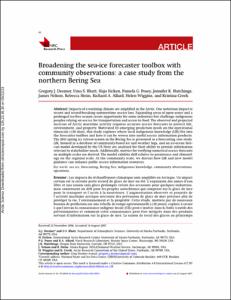Broadening the sea-ice forecaster toolbox with community observations: a case study from the northern Bering Sea.

View/
Average rating
votes
Date
2018Author
Deemer, Gregory J.
Bhatt, Uma S.
Eicken, Hajo
Posey, Pamela G.
Hutchings, Jennifer K.
Nelson, James
Heim, Rebecca
Allard, Richard A.
Wiggins, Helen
Creek, Kristina
Metadata
Show full item recordAbstract
Impacts of a warming climate are amplified in the Arctic. One notorious impact is recent and record-breaking summertime sea-ice loss. Expanding areas of open water and a prolonged ice-free season create opportunity for some industries but challenge indigenous peoples relying on sea ice for transportation and access to food. The observed and projected increase of Arctic maritime activity requires accurate sea-ice forecasts to protect life, environment, and property. Motivated by emerging prediction needs on the operational timescale (<= 10 days), this study explores where local indigenous knowledge (LIK) fits into the forecaster toolbox and how it can be woven into useful sea-ice information products. The 2011 spring ice retreat season in the Bering Sea is presented as a forecasting case study. LIK, housed in a database of community-based ice and weather logs, and an ice-ocean forecast model developed by the US Navy are analyzed for their ability to provide information relevant to stake.....
Resource URL
https://cdnsciencepub.com/doi/10.1139/AS-2016-0054Journal
Arctic ScienceVolume
4Page Range
pp.42-70Document Language
enSustainable Development Goals (SDG)
14.2Spatial Coverage
Arctic OceanBering Sea
Chukchi Sea
Beaufort Sea
DOI Original
http://dx.doi.org/10.1139/as-2016-0054Citation
Deemer, G. J., Bhatt, U. S., Eicken, H., Posey, P. G., Hutchings, J. K., et al. (2018) Broadening the sea-ice forecaster toolbox with community observations: A case study from the northern Bering Sea. Arctic Science, 4, pp.42–70. DOI: https://doi.org/10.1139/as-2016-0054Collections
- CAPARDUS Practices [244]
The following license files are associated with this item:
 Repository of community practices in Ocean Research, Applications and Data/Information Management
Repository of community practices in Ocean Research, Applications and Data/Information Management
